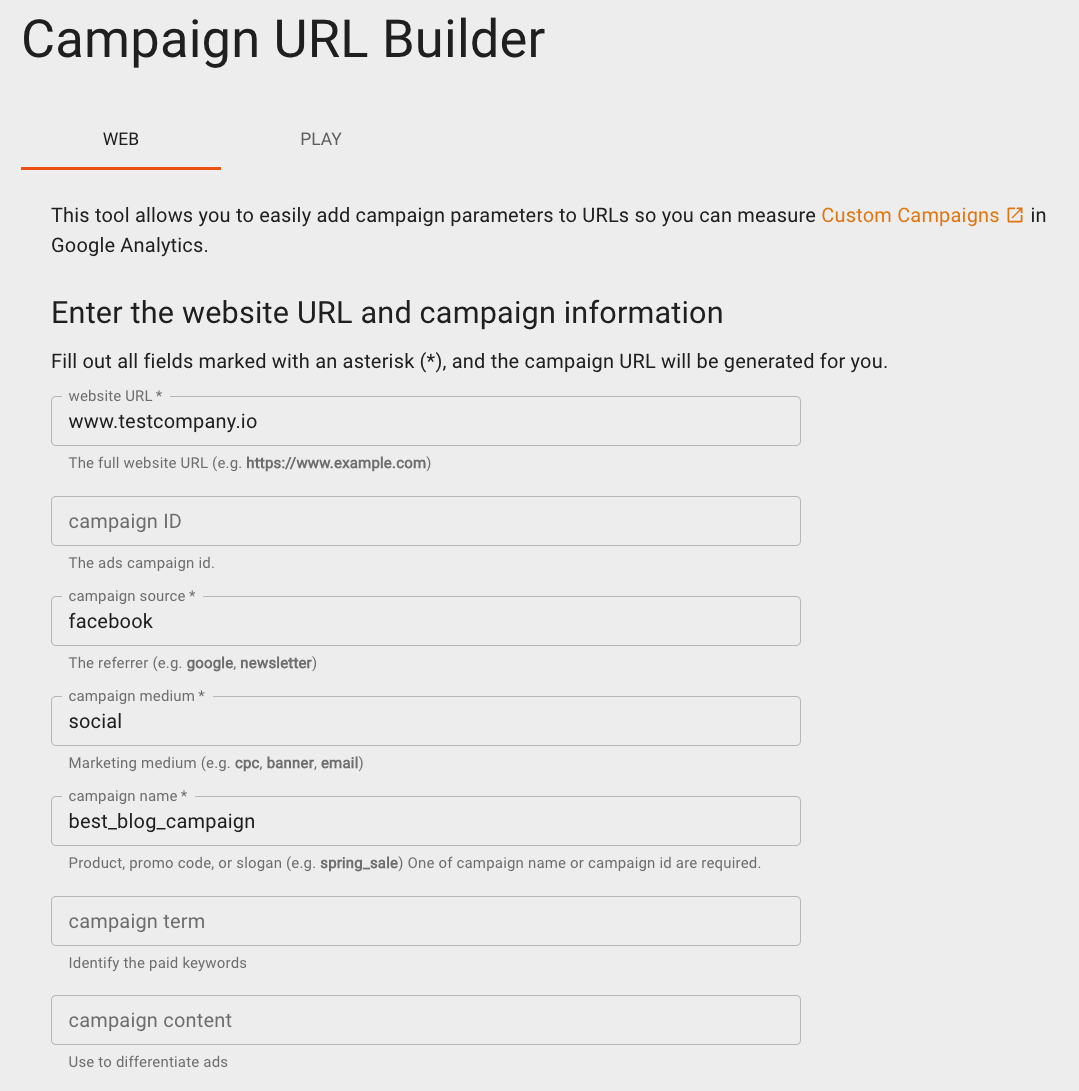The top challenge for brands who run influencer campaigns in-house is measuring ROI.
The average ROI for influencer marketing is 5€ back for every 1€ spent. But if you don't know if the sales coming in are from your influencer campaign, your latest paid advertisements, or from people stumbling upon you on TikTok or Google search...
That 5€ back starts to look a lot like this: ???
70% of brands measure their influencer marketing ROI. Now we have a glass half-full or half-empty situation - because with the help of UTMs, it's actually easy to measure the ROI of your campaigns!
So personally, I think that number should be bigger. Call me crazy, but you deserve to know exactly how your influencer campaign performed. So in this guide, I'm going to detail one of the best tools for measuring your campaign's impact on the business: UTM links.
I'll tell you:
- What are UTMs?
- How to use UTMs for influencer marketing
- How to make the best UTMs possible
And when you combine your UTM links with campaign insights gained from an influencer marketing platform, for example, you'll understand which campaigns drove revenue, which influencers over-performed, and even which products sold more within campaigns!
Let's get into it. (Is it too much to say this is my gift to you-TM?)
Basics of UTMs
So what are UTMs, anyway?
UTM stands for Urchin Tracking Module. The name comes from Urchin Software, who back in the day created a simple code that would attach to a URL and relay where the traffic came from.
Google liked that so much that they bought them way back in 2005. Urchin Software was incorporated into Google Analytics, and it's been a staple of web analytics and digital marketing ever since.
Most likely you’ve seen UTMs as you've trekked around the web. There might even be one at the end of this article! They look like a normal link with strange words and characters at the end bit, like:
www.testcompany.io/blog/best-blog-ever/?utm_source=facebook&utm_medium=social&utm_campaign=best_blog_campaign
While they look awkward (imagine having to type that out by hand), they're vital for digital marketing. UTMs further segment your web traffic on Google Analytics by:
- The source of the traffic, or where it’s coming from,
- The medium that brought the traffic, and
- The campaign that brought the traffic.
Yes, you can already see most of this information on Google Analytics. However, the main benefit is being able to segment your traffic by campaign, and then specific sources and mediums within that campaign.
Google Analytics provides their own tool for creating UTM links, which is free. But depending on your website provider, you may be able to create them there.
So what do you need to create a UTM?
Essentially, UTMs use tags to create a unique link that you can filter through in different campaigns. There are 5 different types of tags, although most likely you’ll only need to worry about 3 or 4 of them for influencer marketing. The tags are:
utm_source - this tag is mandatory for most reporting. This tag’s purpose is simple: it tells you where the traffic came from. So if you're running an influencer campaign on Instagram, that's your source.
utm_medium - this is similar to source, but if your source is Instagram, the medium would be ‘social’. So, for example, you can group all of your social media traffic through this way, and see how much traffic came from different channels via the source tag.
utm_campaign - as you might guess, this tag will help you segment your influencer campaigns from one another. With this tag, you can compare different campaigns against one another, or compare how your campaign affected conversions.
utm_content - this is a tag to identify what brought the user to your site. Commonly you use utm_content to A/B test similar content in the same campaign.
utm_term - this is the search term, and not used outside of paid advertising. Don't worry about this one, as if you know when to use it, you don't need this guide!
With that in our heads, let's take another look at our example:
www.testcompany.io/blog/best-blog-ever/?utm_source=facebook&utm_medium=social&utm_campaign=best_blog_campaign
Here's how this would look if we create it in Google's tool:

After we post the link, we would be able to see exactly how much traffic came from this specific link, which is a link to a blog post, posted to Facebook, as part of our Best Blog Campaign.
However, you can also use this link to segment your traffic further and understand how individual pieces contribute to the campaign as a whole!
For example, with this UTM, you can also see...
- How this link compared to other posts to Facebook (utm_source=facebook)
- How this link compared to other social media posts (utm_medium=social)
- How this post compared to other posts in the same campaign (utm_campaign=best_blog_campaign)
Pretty cool, right?
Okay, let's go over another example, but this time tailored to influencer campaigns.
Corinna, owner of Corinna's Clothes, wants to run an influencer campaign for her new spring releases. She's found four suitable influencers using an influencer marketing platform: Flippo, Roman, Larissa, and Lara.
She wants to test influencer marketing on both Instagram and TikTok, which is great, because Lara and Roman prefer TikTok, while Larissa and Flippo have great followings on Instagram.
To do this, Corinna will need four different UTM links, one for each influencer. So how could those look like?
Let's help Corinna build the right UTM links in the next section!

Photo by @erikakatainen
Using UTMs in your influencer marketing campaign
While there are 5 UTM tags, let's focus on utm_source, utm_medium, and utm_campaign, as those are the most relevant ones.
Corinna starts with utm_source. Because she has influencers coming from both TikTok and Instagram, she'll need two separate source tags: 'tiktok' and 'instagram'.
Her utm_medium tag is simple: social. This allows her to group the posts with her other social posts to understand how social media works for her in general.
Finally, Corinna ends with her campaign tag, as this will allow her to quickly find the right influencer and attribute their link to the right campaign.
She needs to put in the name of her campaign that is easy for her to document, but also put the name of the influencer to understand who posted what.
After choosing a name, her tag ends up being utm_campaign=spring_release_floral_print_mar2022_[influencer name]
The best option is to add as much information as possible to your campaign tag, as then you can see right away who the influencer was and which campaign the traffic came from.
So in the end, for her four influencers, she'll end up with four unique links.
For example, since Roman will promote her products on using TikTok, his link will look like this:
www.corinnasclothes.io/clothes/springcollection/?utm_source=tiktok&utm_medium=social&utm_campaign=spring_release_floral_print_mar2022_roman
We strongly recommend using a unique UTM link for each influencer in your campaign. This does take a bit of work, but the minutes you spend creating these links now will save you hours of work trying to manually measure your return! You can easily see which influencers brought the most traffic and conversions to your site and understand the value generated from each post.
Once the influencer posts their content with your UTM link, you’ll be able to measure the analytics from that specific post in your analytics software. This means you can see the traffic, conversions, drop offs and more that came from your campaign, and understand the impact on a whole new level.
This way, you can see exactly how much traffic came from each individual influencer’s contribution.
Combine this with reach and engagement numbers from the influencer, and you’ll be able to truly prove the best ROI from your campaign!
This also provides you with more information into what content performs better, and the demographics that are more likely to convert.
And finally, with UTMs, you can start comparing your influencer marketing performance to other marketing channels, like organic or paid advertising, to understand which channels drive the most business.
With the UTM links created, Corinna can see:
- How much traffic comes from TikTok, how much traffic comes from Instagram, and compare the two;
- How much traffic comes from social media in general;
- How much traffic each influencer brought and their conversion rate; and
- Which products sold more.
Now, all that's left for Corinna to do is to send the each link to its respective influencer and tell them how to use them!
.jpeg?width=1443&height=2044&name=krista%20seppala%20aidinpaivakirjat%20lumme%20campaign%20(1).jpeg)
Photo by @aidinpaivakirjat
More tips and tricks for UTMs
Before you go and create your own UTM links, there are a few more things to consider that will smooth the creation process.
Remember those other tags we ignored? utm_term is whatever, but utm_content can come in handy. If you have the same influencer promoting multiple products in the same campaign, you can use utm_content to find out which product is more popular.
Say Corinna wants to send shoes and a shirt to her influencers and see which sells better. Then she would simply create two links with the same tags we discussed previously, but different utm_content tags, like this:
/?utm_source=tiktok&utm_medium=social&utm_campaign=spring_release_floral_print_mar2022_roman&utm_content=shirt
/?utm_source=tiktok&utm_medium=social&utm_campaign=spring_release_floral_print_mar2022_roman&utm_content=shoes
This way, she can find out which products were more popular within the campaign, and with each influencer's audience.
And when you combine this data with robust follower demographic data from an influencer marketing platform like Boksi, you'll gain entirely new insights into who interacts with your brand and who buys which products.
Here are some other tips to keep in mind when you're making your UTMs!
Tags are case sensitive. This means that typing 'email', 'e-mail', and 'Email' will all provide unique results. It’s best to use lowercase with all your tags.
Avoid special characters. Tags should be simple, so use a-z and 0-9 to save yourself some headaches. And definitely avoid using ? and & in your tags!
Use a simple nomenclature system. The best thing you can do is standardize your naming system so it’s easy to keep track of your campaigns. But don’t reuse tags over and over, especially campaign tags! This will ruin your reporting. If you run yearly campaigns, add the year to help differentiate them - so ‘summer_campaign’ becomes ‘summer_campaign2020’, ‘summer_campaign2021’ and so on.
Tell the influencer early you plan to use UTM links. Not every influencer may have seen a UTM link before, so some early heads up and education on how to use them will go a long way!
Also remember to double-check that the link is correct during draft review. There is a way to make this process simpler, however...
Use a link shortener when possible. UTM links with all the tags are unwieldy and look just bad, especially if you need to post them in your Instagram profile. So shorten the link with a tool to make things easier.
Here are a few link shorteners to check out:
And that's the gist of it! By adding UTMs to your influencer marketing repertoire, you can drastically improve the insights into your influencer campaigns and identify which campaigns bring the most revenue, which influencers resonate best with your target audience, and ultimately, put a number on that elusive ROI.
If you’re looking for an influencer marketing platform that can help you combine UTM analytics with detailed campaign reports, look no further - Boksi is the perfect solution for you.


.jpeg?width=2000&name=josefina%20prantl%20prisma%20telcollection%20(1).jpeg)

.jpg?)

